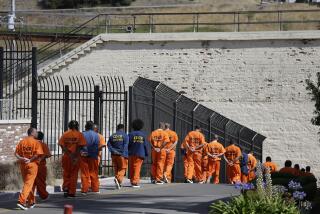Op-Ed: What California can learn from the red states on crime and punishment
Imagine you have the power to decide the fate of someone addicted to heroin who is convicted of petty shoplifting.
How much taxpayer money would you spend to put that person in prison — and for how long? Is incarceration the right form of punishment to change this offender’s behavior?
Those are questions states across the nation are increasingly asking as the costly and ineffective realities of incarceration-only policies have set in. Obviously, we need prisons for people who are dangerous, and there should be harsh punishments for those convicted of violent crimes. But California has been overusing incarceration. Prisons are for people we are afraid of, but we have been filling them with many folks we are just mad at.
Reducing wasteful corrections spending and practices is long overdue in California. The state imprisons five times as many people as it did 50 years ago (when crime rates were similar). And as Californians know, the state’s prison system ballooned over the last few decades and became so crowded that federal judges have mandated significant reductions.
Contributing to the growth in the number of prisoners and in prison spending has been a dramatic expansion in the number of felonies. In addition, mandatory minimum sentences have been applied to an increasing number of crimes. These policies have combined to drive up the prison population, as more prisoners serve longer sentences. On top of that, California has an alarmingly high recidivism rate: Six out of 10 people exiting California prisons return within three years.
It makes no sense to send nonserious, nonviolent offenders to a place filled with hardened criminals and a poor record of rehabilitation — and still expect them to come out better than they went in. Studies show that placing low-risk offenders in prison makes them more dangerous when they are released.
Over-incarceration makes no fiscal sense. California spends $62,396 per prisoner each year, and $10 billion overall, on its corrections system. That is larger than the entire state budget of 12 other states. This expenditure might be worth it if we were safer because of it. But with so many offenders returning to prison, we clearly aren’t getting as much public safety — or rehabilitation — as we should for this large expenditure.
Meanwhile, California spends only $9,200 per K-12 student, and the average salary for a new teacher is $41,926. And as California built 22 prisons in 30 years, it built only one public university.
California is not alone in feeling the financial (and public safety) consequences of over-incarceration. Several states — politically red states, we would point out — have shown how reducing prison populations can also reduce cost and crime.
Most notably, Texas in 2007 stopped prison expansion plans and instead used those funds for probation and treatment. It has reduced its prison population, closed three facilities and saved billions of dollars, putting a large part of the savings into drug treatment and mental health services. Better yet, Texas’ violent crime rates are the lowest since 1977.
Another red state, South Carolina, made similar reforms for nonviolent offenses. The drop in the number of prisoners allowed South Carolina to close one prison and also lower its recidivism rate. Other states (Ohio, Georgia, Oklahoma, Kentucky, Missouri, Pennsylvania and Mississippi) have similarly shifted their approach to nonviolent convictions.
Now voters in California will have a chance to do the same, using costly prison beds for dangerous and hardened criminals. It is time to stop wasting taxpayer dollars on locking up low-level offenders. Proposition 47 on the November ballot will do this by changing six nonviolent, petty offenses from felony punishments (which now can carry prison time) to misdemeanor punishments and local accountability.
The measure is projected to save hundreds of millions of taxpayer dollars per year, and it will help the state emphasize punishments such as community supervision and treatment that are more likely to work instead of prison time.
Take the example of Ray Rivera of San Diego, who represents a very common experience. Rivera was addicted to drugs from early in life. At age 24, he stole $50 of merchandise from a store to buy drugs, and was sentenced to prison.
Instead of being held accountable and confronting his drug habit through treatment, Rivera languished in prison and came out in worse shape. It wasn’t until he was out of the justice system that he sought and found the treatment he needed and cleaned up his life. Sending him to prison was a waste.
If so many red states can see the importance of refocusing their criminal justice systems, California can do the same. It’s not often the voters can change the course of a criminal justice system. Californians should take advantage of the opportunity and vote yes on Proposition 47.
Newt Gingrich, a former speaker of the House of Representatives, is a co-host of CNN’s “Crossfire.” B. Wayne Hughes Jr., a California businessman, is founder and chairman of the board of Serving California, a foundation that helps ex-offenders, crime victims and veterans.
Follow the Opinion section on Twitter @latimesopinion
More to Read
A cure for the common opinion
Get thought-provoking perspectives with our weekly newsletter.
You may occasionally receive promotional content from the Los Angeles Times.





